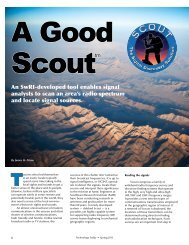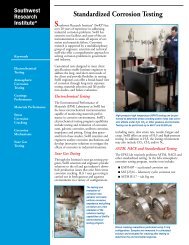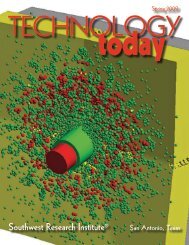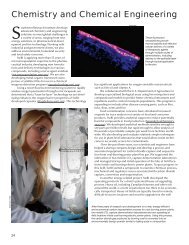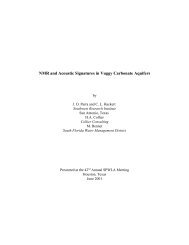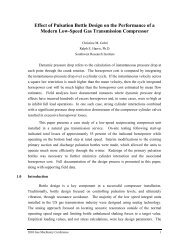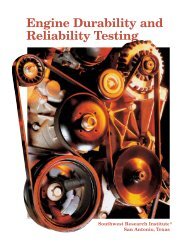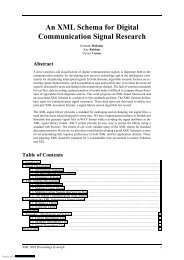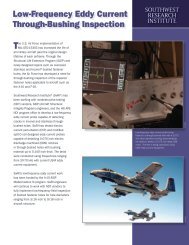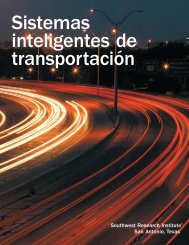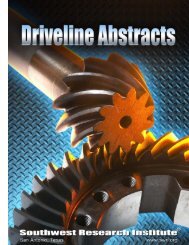gmrc advanced reciprocating compressor technology - Southwest ...
gmrc advanced reciprocating compressor technology - Southwest ...
gmrc advanced reciprocating compressor technology - Southwest ...
You also want an ePaper? Increase the reach of your titles
YUMPU automatically turns print PDFs into web optimized ePapers that Google loves.
Conceptual drawings of the prototype TSBA installation<br />
at the SwRI <strong>reciprocating</strong> <strong>compressor</strong> test facility (RCTF) are<br />
presented in Figure 3. A span of 1 in. (2.5 cm) diameter<br />
piping connects the variable volume to the 3 in. (7.6 cm)<br />
diameter main gas piping. The RCTF <strong>compressor</strong> piping<br />
system had a lateral resonance at two times the <strong>compressor</strong><br />
running speed (2x), which was the target issue of the prototype<br />
TSBA.<br />
The prototype TSBA was installed in the RCTF, as<br />
shown in Figure 4. As previously described, the choke<br />
tube strategically attaches the variable volume to the<br />
main gas piping. Figure 5 summarizes measured pulsations<br />
over a <strong>compressor</strong> speed range of 600 to 900 rpm<br />
with and without the TSBA. The line marked with diamonds<br />
shows the piping resonance without the TSBA installed.<br />
The line marked with squares shows the characteristic<br />
pulsation spectrum (a valley with two peaks) of a<br />
TSBA tuned to a single frequency. The line marked with<br />
triangles shows the measured pressure pulsations with<br />
the TSBA manually tuned to track <strong>compressor</strong> running<br />
speed. The ability to tune the SBA enables successful operation<br />
over a wider speed range. The valley between the<br />
two peaks created by installing the TSBA is varied as the<br />
operating speed varies.<br />
■ Figure 6. Automation control software for tuning the TSBA.<br />
■ Figure 4.<br />
Prototype TSBA<br />
installed in the<br />
RCTF piping<br />
system.<br />
■ Figure 7. Measured data for uncontrolled TSBA vs. TSBA with automated<br />
control.<br />
■ Figure 5. Measured pulsation data with manual control of TSBA<br />
frequency.<br />
Automated control of the TSBA was then implemented.<br />
Temperature and <strong>compressor</strong> speed real-time inputs were<br />
JUNE 2007<br />
used to determine the initial quick tuning of the TSBA.<br />
Temperature enables a more accurate approximation of the<br />
gas sound speed — <strong>compressor</strong> speed is needed to determine<br />
the approximate frequency of 2x. The controller then<br />
fine-tunes the TSBA based on the real-time pulsations feedback.<br />
A screen shot of the software written to control the<br />
TSBA tuning is presented in Figure 6. Data recorded with<br />
the TSBA uncontrolled showed a distinct 2x lateral resonance.<br />
However, the 2x resonance peak was not noticeable<br />
with the TSBA automatically tuned by the controller system.<br />
A direct comparison of the data (Figure 7) shows that much<br />
lower pulsations are present when the TSBA is automatically<br />
controlled than when it is not controlled (and fixed at<br />
minimum volume).<br />
Pulsations were about four to 21 times lower with the<br />
TSBA installed as an integral part of the acoustically resonant<br />
piping system. The TSBA can be used successfully<br />
over wide speed ranges and in systems where operating<br />
conditions may vary significantly. The relatively simple<br />
and rugged design should make it easy to install in an existing<br />
piping system. The prototype TSBA was able to significantly<br />
reduce pulsations caused by coincidence of<br />
<strong>compressor</strong>-generated pulsations with the piping acoustic<br />
resonance.<br />
Although the data presented illustrates the effectiveness of<br />
the TSBA over a wide speed range, it is important to note<br />
that the TSBA can also be implemented over a variable<br />
range of molecular weights. Probably the single most important<br />
feature of the TSBA is that it can replace pressure drop<br />
damping (orifice installation) for reduction of low-frequency<br />
pulsations. Orifices, which are also used to effectively<br />
COMPRESSORTech Two



